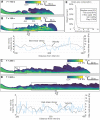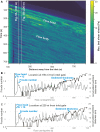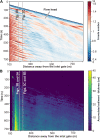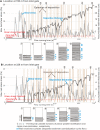How is a turbidite actually deposited?
- PMID: 35044818
- PMCID: PMC8769550
- DOI: 10.1126/sciadv.abl9124
How is a turbidite actually deposited?
Abstract
The deposition of a classic turbidite by a surge-type turbidity current, as envisaged by conceptual models, is widely considered a discrete event of continuous sediment accumulation at a falling rate by the gradually waning density flow. Here, we demonstrate, on the basis of a high-resolution advanced numerical CFD (computational fluid dynamics) simulation and rock-record examples, that the depositional event in reality involves many brief episodes of nondeposition. The reason is inherent hydraulic fluctuations of turbidity current energy driven by interfacial Kelvin-Helmholtz waves. The experimental turbidity current, with realistic grain-size composition of a natural turbidite, used only 26 to 33% of its in-place flow time for deposition, while the remaining time went to the numerous episodes of sediment bypass and transient erosion. The general stratigraphic notion of a gross incompleteness of sedimentary record may then extend down to the deposition time scale of a single turbidite.
Figures






References
-
- Dżułyński S., Książkiewicz M., Kuenen P. H., Turbidites in flysch of the Polish Carpathian Mountains. Geol. Soc. Am. Bull. 70, 1089–1118 (1959).
-
- Sestini G., Flysch facies and turbidite sedimentology. Sediment. Geol. 4, 559–597 (1970).
-
- Normark W. R., Posamentier H., Mutti E., Turbidite systems: State of the art and future directions. Rev. Geophys. 31, 91–116 (1993).
-
- Talling P. J., Masson D. G., Sumner E. J., Malgesini G., Subaqueous sediment density flows: Depositional processes and deposit types. Sedimentology 59, 1937–2003 (2012).
-
- Jobe Z. R., Howes N., Romans B. W., Covault J. A., Volume and recurrence of submarine-fan-building turbidity currents. Depos. Rec. 4, 160–176 (2018).
LinkOut - more resources
Full Text Sources
Miscellaneous

